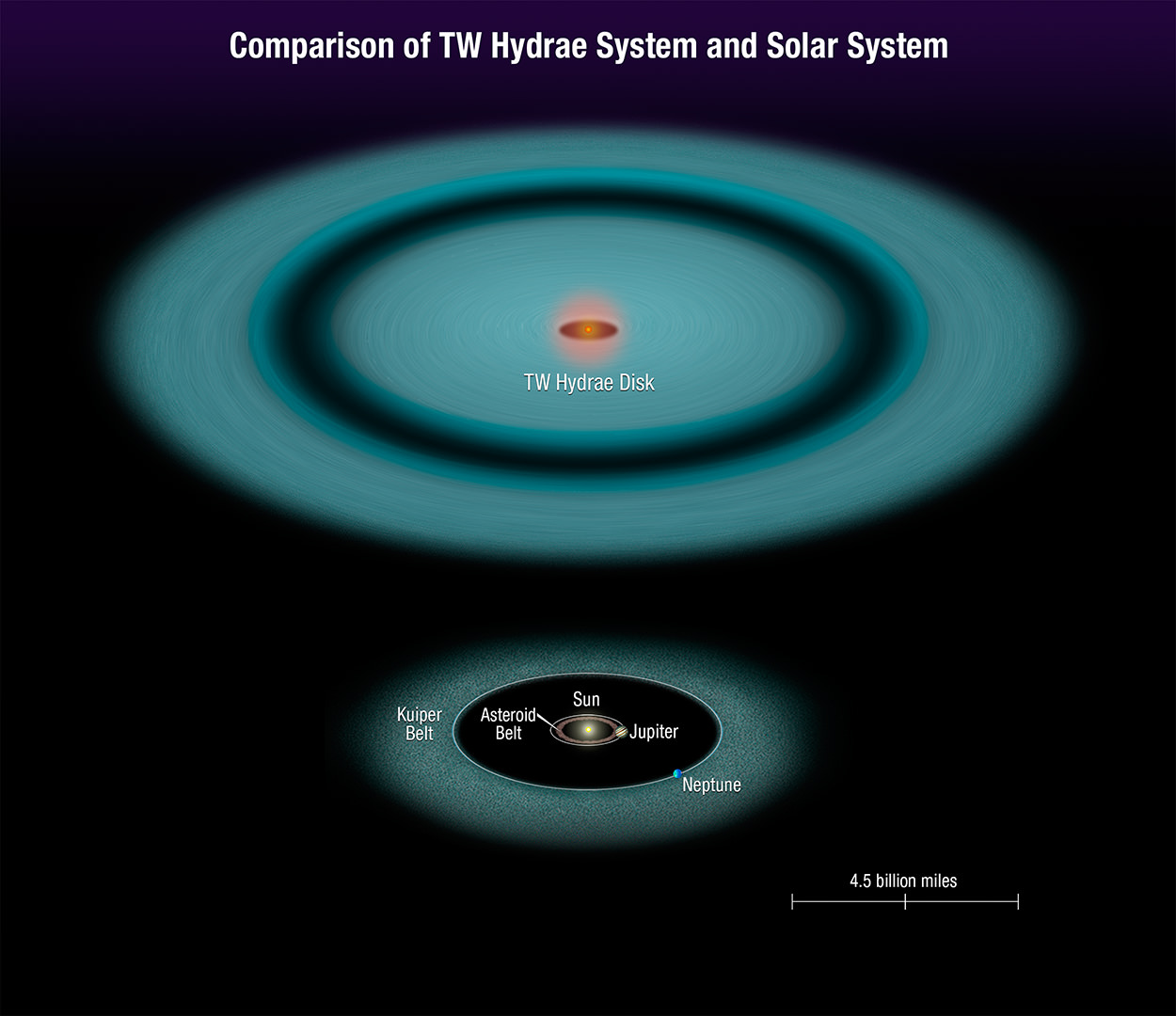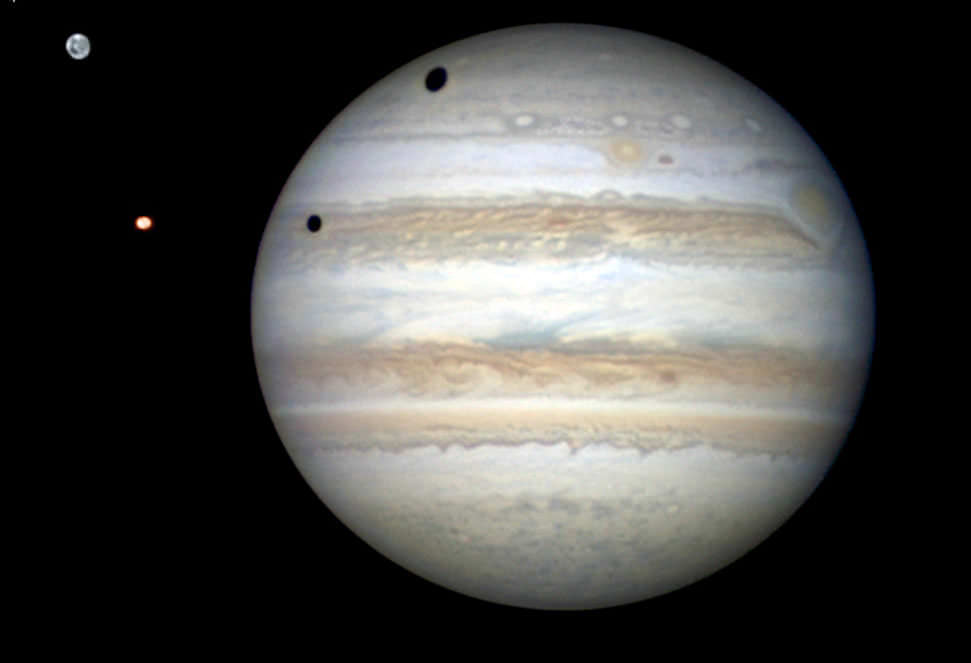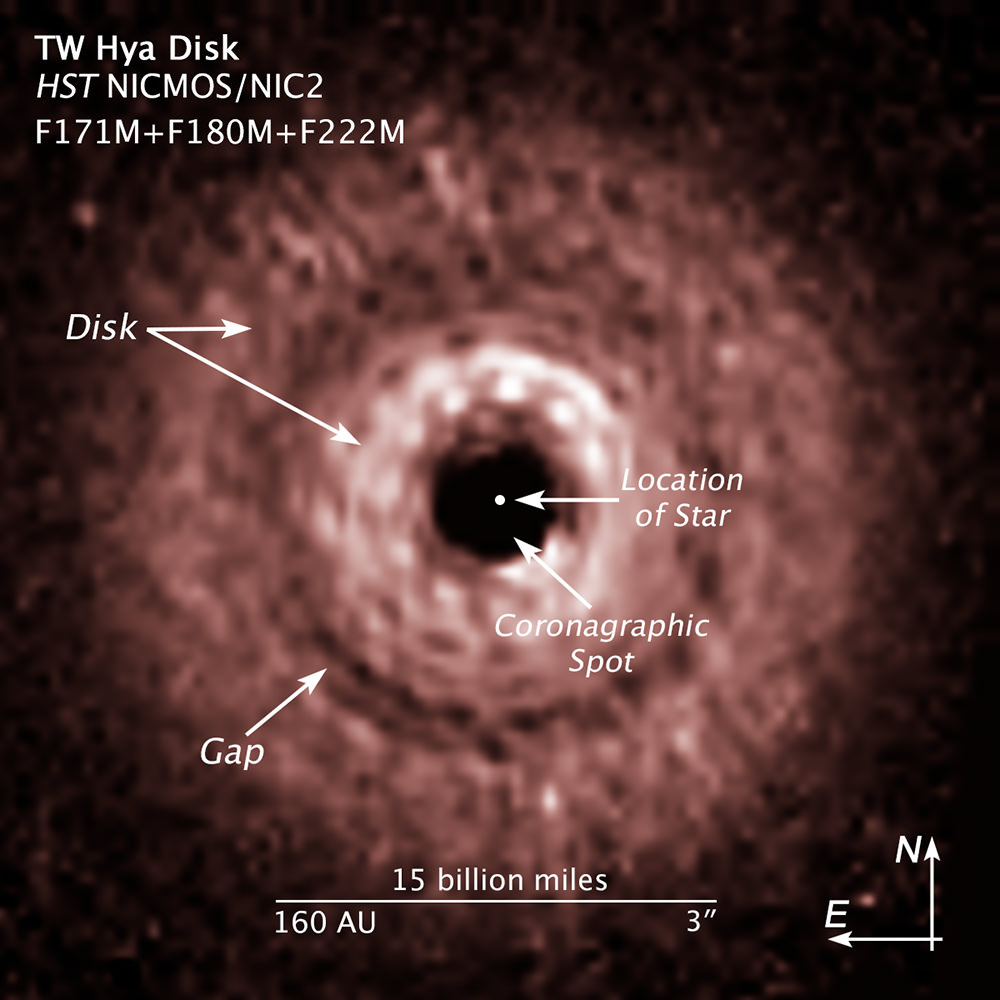Take a close look at the blurry image above. See that gap in the cloud? That could be a planet being born some 176 light-years away from Earth. It’s a small planet, only 6 to 28 times Earth’s mass.
That’s not even the best part.
This alien world, if we can confirm it, shouldn’t be there according to conventional planet-forming theory.
The gap in the image above — taken by the Hubble Space Telescope — probably arose when a planet under construction swept through the dust and debris in its orbit, astronomers said.
That’s not much of a surprise (at first blush) given what we think we know about planet formation. You start with a cloud of debris and gas swirling around a star, then gradually the bits and pieces start colliding, sticking together and growing bigger into small rocks, bigger ones and eventually, planets or gas giant planet cores.
But there’s something puzzling astronomers this time around: this planet is a heck of a long way from its star, TW Hydrae, about twice Pluto’s distance from the sun. Given that alien systems’ age, that world shouldn’t have formed so quickly.

Astronomers believe that Jupiter took about 10 million years to form at its distance away from the sun. This planet near TW Hydrae should take 200 times longer to form because the alien world is moving slower, and has less debris to pick up.
But something must be off, because TW Hydrae‘s system is believed to be only 8 million years old.
“There has not been enough time for a planet to grow through the slow accumulation of smaller debris. Complicating the story further is that TW Hydrae is only 55 percent as massive as our sun,” NASA stated, adding it’s the first time we’ve seen a gap so far away from a low-mass star.
The lead researcher put it even more bluntly: “Typically, you need pebbles before you can have a planet. So, if there is a planet and there is no dust larger than a grain of sand farther out, that would be a huge challenge to traditional planet formation models,” stated John Debes, an astronomer at the Space Telescope Science Institute in Baltimore.

At this point, you would suppose the astronomers are seriously investigating other theories. One alternative brought up in the press release: perhaps part of the disc collapsed due to gravitational instability. If that is the case, a planet could come to be in only a few thousand years, instead of several million.
“If we can actually confirm that there’s a planet there, we can connect its characteristics to measurements of the gap properties,” Debes stated. “That might add to planet formation theories as to how you can actually form a planet very far out.”

There’s a trick with the “direct collapse” theory, though: astronomers believe it takes a bunch of matter that is one to two times more massive than Jupiter before a collapse can occur to form a planet.
Recall that this world is no more than 28 times the mass of Earth, as best as we can figure. Well, Jupiter itself is 318 times more massive than Earth.
There are also intriguing results about the gap. Chile’s Atacama Large Millimeter/submillimeter Array (ALMA) — which is designed to look at dusty regions around young stars — found that the dust grains in this system, orbiting nearby the gap, are still smaller than the size of a grain of sand.
Astronomers plan to use ALMA and the James Webb Space Telescope, which should launch in 2018, to get a better look. In the meantime, the results will be published in the June 14 edition of the Astrophysical Journal.
Source: HubbleSite


Now THAT is an interesting image! Am wondering if that gap could be evidence of a small black hole orbiting the star? Also… notice that on the side opposite of the cleared area there is a brighter portion in the dust/gas ring. MOST interesting of all are the 12 white ‘blobs’ radially displaced equally around the star. Outboard of that are co-responding, alternately spaced, dark or cleared areas…. very interesting!
were it a black hole there’d be X-Rays etc. emitted by matter infalling to the BH
Wouldn’t that depend on the amount of matter currently being swept up? What does data from X-ray obs. say?
Why do you even think this is a black hole? Wouldn’t something less dense be much more likely?
By their nature, stable black holes are always MUCH more massive than stars.
(Note: I said “massive” not “large”.)
So even IF it were a black hole, the star would be orbiting IT, because it’s mass that dictates gravitational pull.
In principle, a black hole can have any mass equal to or above the Planck mass (about 22 micrograms).
I don’t see where you’re getting the energy to create a singularity from.
An astrophysical black hole, a black hole produced by astrophysical processes involving gravitational accretion, are 3.2 solar masses or larger. If this object were a black hole it would have an event horizon radius of less than 28cm, or less than about 11 inches. The energy density required for this is far in excess of standard astrophysical processes. This could only plausibly, but not likely, have occurred at some phase in the big bang.
LC
I would say those equally spaced blobs are image artefacts, and not real.
Seems we need to have that horse vs zebra discussion again.
Empirically we look for the most likely explanation, not the least likely. The rare but factual phenomena becomes more exciting that way too, so it is a win-win.
– Planets are known to form out of disks, black holes are known to not form that way.
– Image and scope artifacts is the first thing to check. And lo, coronagraph images all have these semi-regular spokes. I think it would be expected, it is likely the remnants of the scope spokes and heavy image processing both.
You can lead a horse to water…..
I wonder if we are seeing a rogue planet being captured by a young star?
Or perhaps a planet that just happened to form in the same area as TW Hydrae? The whole area is a stellar nursery …
The difficulty with those hypotheses is that capturing a planet requires a third object to perturb it into a bound orbit, so you basically have to have a planet there already. That, and the thin-ness of the gap in the disc suggests to me that the planet has a nearly circular orbit.
Not a chance on both accounts. The gap and therefore the planet is perfectly aligned with the equatorial plane of the dust disc. However it formed, it happened within the disc itself after the disc had formed. Gravitational instability should be the right answer here.
Thanks!
failed binary?
Coagulation. I think some gases and masses clump together faster than they do in other planetary formations.
Has anyone considered the possibility that there are multiple planets with a similar distance and eccentricity relative to the parent star? This would to me be a logical conclusion as to why there is such a large gap — more than one planet is located there.
http://stargate.wikia.com/wiki/Planet_builder
The star ignited twice just like our star?
Seems giant formation by gravitational instability (GI) proponents have jumped on this, because the disc is young. Likely because the balance of results have slowly but steadily tipped in favor of core collapse (CC) giant formation in recent years.
While GI can’t be excluded, I am fairly skeptical. The age of the disk is not stressing CC, which comes in about 1 million year formation time from other observation. And then GI has worse problem than GC, since GC can form neptunes (~20-40 Earth masses, IIRC).
Core aggregation has always had problems. More likely this shows that it is easier than we think, but that we have not the right idea on how disks goes from grains to super-Earth size planets.
Yes.. it IS much more likely that this gap was formed by a proto planet, but I like looking at all the possibilities…. aka… What if? I got you thinking at the very least….
I’m not a scientist, but that would IMO make for a very unstable system. So either it IS that and we’ve caught it before any multi-body interactions take their toll or it’s not. Again, IM (uninformed) O…
Depends on how large the gap is. This star is a young star, and young stars often have numerous planets orbiting each other, bashing into one another. This is how the solar system looked when the moon was born for example — when the planet Theia impacted the planet Earth.